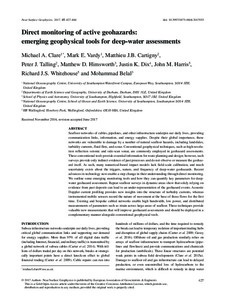Direct monitoring of active geohazards: emerging geophysical tools for deep-water assessments.

View/
Average rating
votes
Date
2017Author
Clare, Michael A.
Vardy, Mark E.
Cartigny, Matthieu J.B.
Talling, Peter J.
Himsworth, Matthew D.
Dix, Justin K.
Harris, John M.
Whitehouse, Richard J.S.
Belal, Mohammad
Metadata
Show full item recordAbstract
Seafloor networks of cables, pipelines, and other infrastructure underpin our daily lives, providing
communication links, information, and energy supplies. Despite their global importance, these
networks are vulnerable to damage by a number of natural seafloor hazards, including landslides,
turbidity currents, fluid flow, and scour. Conventional geophysical techniques, such as high-resolution
reflection seismic and side-scan sonar, are commonly employed in geohazard assessments.
These conventional tools provide essential information for route planning and design; however, such
surveys provide only indirect evidence of past processes and do not observe or measure the geohazard
itself. As such, many numerical-based impact models lack field-scale calibration, and much
uncertainty exists about the triggers, nature, and frequency of deep-water geohazards. Recent
advances in technology now enable a step change in their understanding through direct monitoring.
We outline some emergi.....
Journal
Near Surface GeophysicsVolume
15Page Range
pp.427-444Document Language
enSustainable Development Goals (SDG)
14.ABest Practice Type
Manual (incl. handbook, guide, cookbook etc)DOI Original
10.3997/1873-0604.2017033Citation
Clare, M.A. ; Vardy, M.E.; Cartigny, M.J.B.; Talling, P.J.; Himsworth, M.D.; Dix, J.K.; Harris, J.M.; Whitehouse, R.J.S. and Belal, M. (2017) Direct monitoring of active geohazards: emerging geophysical tools for deep-water assessments. Near Surface Geophysics, 15, pp.427-444. DOI: https://doi.org/10.3997/1873-0604.2017033Collections
The following license files are associated with this item:
 Repository of community practices in Ocean Research, Applications and Data/Information Management
Repository of community practices in Ocean Research, Applications and Data/Information Management
